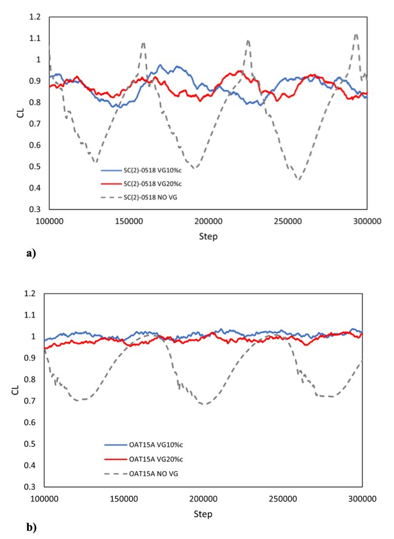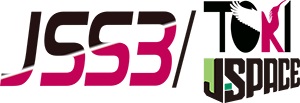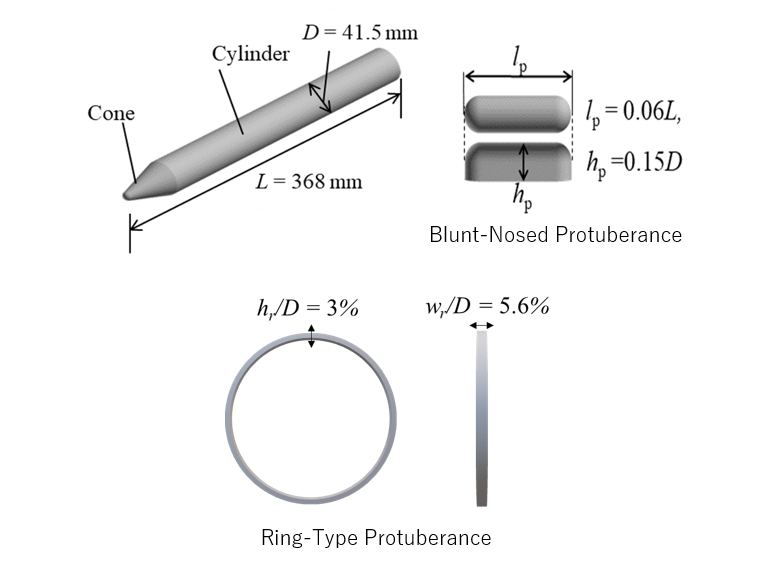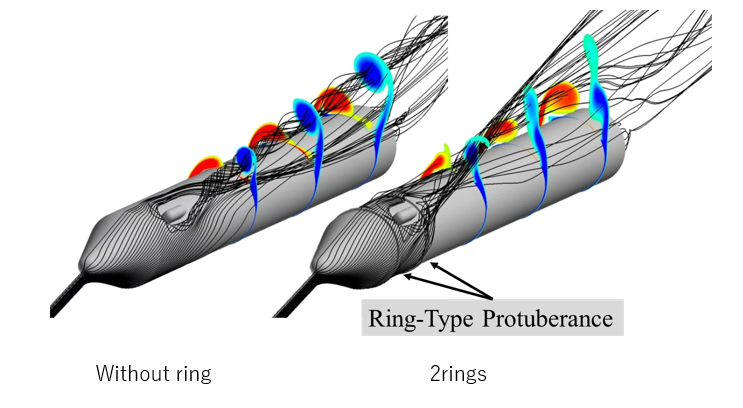Numerical Fluid Analysis of Supersonic Flying Vehicle
JAXA Supercomputer System Annual Report February 2023-January 2024
Report Number: R23EACA20
Subject Category: JSS Inter-University Research
- Responsible Representative: Keiichi Kitamura, Associate Professor, Yokohama National University
- Contact Information: Keiichi Kitamura, Yokohama National University(kitamura@ynu.ac.jp)
- Members: Gaku Fukushima, Keiichi Kitamura, Kazuki Nimura, Yuta Tsukamoto
Abstract
This study investigates the aerodynamic characteristics of rockets and wings with shock waves. The first is to investigate the effect of ring-type protuberance, such as flanges, on the aerodynamic characteristics of rockets. The second is to select an appropriate numerical method to predict buffeting, which is extremely difficult to predict by numerical simulations (shock wave generation on wings at transonic speeds), and to investigate the effect of VortexGenerator, a numerical method that is believed to effectively suppress transonic buffeting.
Reference URL
N/A
Reasons and benefits of using JAXA Supercomputer System
The study of rockets with protuberances requires accurate capture of the surrounding vortex, and numerical calculations are performed using a high-resolution computational grid. Moreover transonic buffet is an unsteady phenomenon which requires high computational resources. In order to calculate such complex flowfield, we will use a method called Zonal DES, which calculates near – wall region in RANS, and LES ouside of it, which demands for high CPU cost. By using JSS for this research, we would be able to use multiple high-performance CPUs, converging our calculations even faster.
Achievements of the Year
1. Study of rokets with protuberances
One blunt-nosed protuberance was attached to the downwind side of the front of the aircraft for an slender body with a slenderness ratio of 8.9, as shown in Figure 1. In addition, up to two ring-type protuberance were placed in front of and behind the blunt-nosed protuberance in an attempt to suppress the large side force generated by the blunt-nosed protuberance. As a result, as shown in Figure 2, the flow is interrupted and disturbed by the ring-type protuberance, and the asymmetric vortex that causes the side forces is partially scattered. As a result, the asymmetry of the vortex is reduced and the side force is reduced by up to 49%.
2. Study of transonic buffet
Numerical calculations of transonic buffet were performed on two supercritical airfoils, SC(2)-0518 and OAT15A, utilizing Zonal DES to accurately replicate the shock wave buffet phenomenon. VGs were used for the suppression of shock wave oscillations. A parametric study was conducted with blade-type VGs, varying their attachment positions on the airfoil at 10% and 20% of the chord length.
From the numerical calculations on the VG-less airfoils, we successfully reproduced the transonic shock wave buffet, and its oscillation frequencies were consistent with experimental data. The Zonal DES approach—calculating flow in RANS mode near the wall and in LES mode outside this region—resolved unsteady, finer flow details more precisely than RANS and with less computational demand than WMLES. The time-averaged pressure coefficient on the airfoil also showed a close match with the experimental results.
Application of VGs revealed a suppression effect on the unsteady shock wave oscillations for both airfoils, contributing to transonic buffet suppression. Analysis of the lift coefficient time histories indicated that, while small amplitude CL fluctuations persisted for both airfoil types with VGs attached, the amplitudes of the larger CL fluctuations were dampened, confirming the effectiveness of the VGs (Fig. 3). Additionally, a minor increase in CL was observed in the 10%c-attached VG cases on both airfoils, with a 0.23% increase on SC(2)-0518 and a 2.5% increase on OAT15A, compared to the 20%c cases .

Fig.3: Lift coefficient time history for VG-equipped cases: a) CL history for the SC(2)-0518 airfoil and b) CL history for the OAT15A airfoil. The dashed lines represent the CL history for cases without VGs for comparison.
Publications
– Peer-reviewed papers
1. Nimura, K., Tsutsui, F., Kitamura, K., and Nonaka, S.: Aerodynamic Effects of Surface Protuberance Size on Slender-bodied Supersonic Vehicle, Journal of Spacecraft and Rockets, https://doi.org/10.2514/1.A35714
2. Motoki, S., Nimura,K., Magara, M., Kitamura, K., and Nonaka, S.:Effects of Protuberance Size on Side Force Characteristics of Slender Body at Mach 0.7 and 1.3, JSASS. Aerospace Technology Japan, Vol. 22, 2023, pp. 71-78
– Oral Presentations
1. Yuta Tsukamoto, Keiichi Kitamura, “Numerical Simulations on Shock-Wave/Vortex-Generator-Induced-Wake Interactions over Supercritical Airfoils,” The 61st Aircraft Symposium, 2023
2. Kazuki Nimura, Kouya Nakahara, Kouya Mineshima, Hibiki Kumai, Keiichi Kitamura, Satoshi Nonaka, “Effect of Ring-Type Protuberance on Side Force Reduction for Slender Body at Mach 0.7 and 1.3”, Symposium on the Dynamics of Space Navigation, 2023
– Poster Presentations
Yuta Tsukamoto ,”Numerical Study on a Supercritical Airfoil: Interactions of Vortex Generator-Induced Wake and Shock Waves,” Twentieth International Conference on Flow Dynamics (ICFD2023), 2023
Kazuki Nimura, Keiichi Kitamura, Satoshi Nonaka, “Effect of Ring-Type Protuberance on Side Force Reduction for Slender Body”,The 67th Space Science and Technology Union Conference,2023
Usage of JSS
Computational Information
- Process Parallelization Methods: MPI
- Thread Parallelization Methods: Automatic Parallelization
- Number of Processes: 1024 – 2048
- Elapsed Time per Case: 12 Hour(s)
JSS3 Resources Used
Fraction of Usage in Total Resources*1(%): 0.11
Details
Please refer to System Configuration of JSS3 for the system configuration and major specifications of JSS3.
| System Name | CPU Resources Used(Core x Hours) | Fraction of Usage*2(%) |
|---|---|---|
| TOKI-SORA | 2541375.40 | 0.11 |
| TOKI-ST | 58627.79 | 0.06 |
| TOKI-GP | 0.00 | 0.00 |
| TOKI-XM | 0.00 | 0.00 |
| TOKI-LM | 12229.10 | 0.93 |
| TOKI-TST | 0.00 | 0.00 |
| TOKI-TGP | 0.00 | 0.00 |
| TOKI-TLM | 0.00 | 0.00 |
| File System Name | Storage Assigned(GiB) | Fraction of Usage*2(%) |
|---|---|---|
| /home | 571.67 | 0.47 |
| /data and /data2 | 36723.33 | 0.23 |
| /ssd | 3346.67 | 0.32 |
| Archiver Name | Storage Used(TiB) | Fraction of Usage*2(%) |
|---|---|---|
| J-SPACE | 0.00 | 0.00 |
*1: Fraction of Usage in Total Resources: Weighted average of three resource types (Computing, File System, and Archiver).
*2: Fraction of Usage:Percentage of usage relative to each resource used in one year.
ISV Software Licenses Used
| ISV Software Licenses Used(Hours) | Fraction of Usage*2(%) | |
|---|---|---|
| ISV Software Licenses(Total) | 1961.70 | 0.89 |
*2: Fraction of Usage:Percentage of usage relative to each resource used in one year.
JAXA Supercomputer System Annual Report February 2023-January 2024




